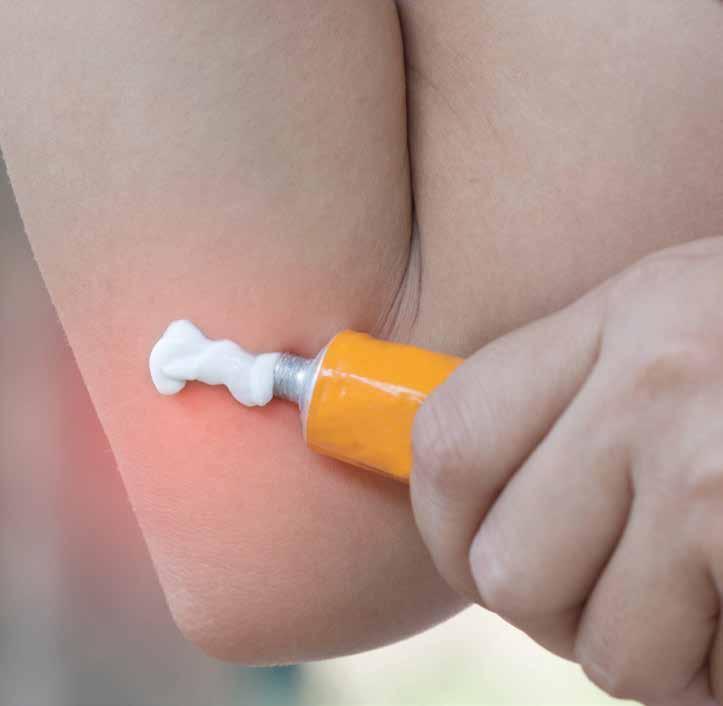FOOT CARE
29
FOOT CARE Every day, feet are abused and bruised, which is why so many experience heel pain, blisters, corns and calluses. However, despite a high prevalence of foot care conditions, few people actually opt to treat them. A major part of the problem surrounding reluctance to treat is confusion. With over 15 different ailments in foot care, this is a category that spans a hugely diverse number of consumer needs. There are also issues with daily foot comfort and posture. An overarching lack of awareness about available solutions is the key reason why people are not doing enough about general discomfort.
COMMON PROBLEMS AND TREATMENTS Corns and calluses - are a build-up of hard dead skin caused by pressure when bony parts of the feet rub against the shoes. Wearing shoes that fit better or using special pads may solve the problem. If corns or calluses become painful, patients should be advised to visit the chiropodist or doctor. Over-the-counter treatments for corns, such as corn plasters, are available. Corn plasters may not be suitable for certain people, such as those with diabetes, circulation problems, or fragile skin. Bunions - develop when the joints of the big toe no longer fit together. This causes a painful swelling which makes walking difficult. Wearing shoes made of soft leather or fabric uppers, or bunion shields may help to ease the discomfort. A chiropodist or doctor will advise on how to treat the condition. Athlete’s Foot - is a fungal infection and is very contagious. It causes dry skin, an itchy rash, splitting of the skin between the toes and blisters on the skin under the toes. To prevent infection advise patient to keep feet – especially the area between toes – clean and dry. Change shoes, socks, tights or stockings often. Over-the-counter antifungal creams are sufficient for treating most cases of athlete’s foot. If the condition does not get better within two weeks, advise a visit to chiropodist or GP.
Verrucas are highly contagious and spread easily through contact with contaminated changing room floors or swimming pool areas. They usually disappear on their own, but this can take up to two years. Several treatment options are available OTC, including salicylic acid gels, creams, plasters and paints, and cryotherapy products. Cracked heels - often caused by openbacked shoes, such as sandals or flip-flops rubbing the skin. Applying a moisturising cream or specially formulated foot cream, twice daily, will keep feet smooth and soft. Any hard skin can be removed with a pumice stone or non-metal foot file; these are most effective when used during a bath or shower. Blisters - can be painful and are more likely to occur in hot weather, when sandals or flipflops rub against the skin. Anti-blister sticks and blister plasters can provide instant relief and prevent further damage. Customers should be advised not to pop blisters, as this increases the risk of infections – instead, they should cover them with a protective gel dressing. Fungal nail infections - most common in people who wear shoes in hot sweaty weather, regularly damage their nail or skin, or have certain health conditions such as
W
In-growing toenails - can be very painful and are usually caused by cutting the toenail too short or by wearing shoes that are too tight. A chiropodist or GP will advise on how to treat the condition. OTC soaks are available to help relieve pain or swelling and pain-relieving medication can also be recommended.
W
Verrucas - Most verrucas, which develop on the soles of the feet, are harmless. They don’t cause any pain, unless they are on a weight-bearing part of the foot. The affected skin is usually white and may have a black spot in the centre.
A
H
M
diabetes or psoriasis. The infection usually develops slowly and causes the nail to become thickened and discoloured. The nail may turn white, black, yellow or green, but isn’t usually painful. Mild fungal nail infections usually clear up on their own, although a GP may check for any underlying conditions. Antifungal nail paint may be effective if only the end of the nail is infected, but this needs to be used for up to six months or even a year. Antifungal tablets are up to 80 per cent effective, but again need to be taken for several months. Most treatment failure occurs because people stop using the medicines too early. In severe or painful cases, the nail may be removed with surgery. Feet odours - teenagers and pregnant women are particularly prone to sweaty feet, because hormonal changes make them sweat more often. Ideally, customers should wash their feet every morning and night with warm soapy water and change their socks at least once a day. An antibacterial wash, followed by a wipe with cotton wool soaked in surgical spirit, can help to combat any odour. Medicated insoles and ‘feet fresh’ socks have a deodorising effect.
Who? Everyone is prone to foot problems, particularly those who are on their feet for most of the day. What are the symptoms? There are a wide range of common foot problems with a wide range of symptoms. How long has the patient had the symptoms? Many patients are confused about the range of foot ailments so do not tackle discomfort early. Action already taken? Using appropriate footwear for the conditions can alleviate or prevent many foot ailments. Medication? A wide range of OTC products are available.






















